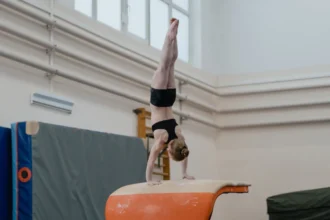All gymnastics routines, including those on the balance beam, are subject to specific timing rules. These routines must be choreographed not only to showcase the gymnast’s skills but also to fit within the time limits.
1. Rules of Balance Beam Routines
The balance beam is a narrow apparatus, typically about 4 inches wide and 16 feet long, elevated off the ground. It has evolved significantly since its inception, becoming a central piece in women’s gymnastic competitions.
According to the International Gymnastics Federation, balance beam routines for women must not exceed 90 seconds. Timing starts when the gymnast makes her first move and stops when her feet hit the mat on dismount. Going over time can result in deductions that might impact the final score significantly.
2. Implications for Gymnasts
The balance beam demands a high level of technical skill, from acrobatic flips and spins to precise dance movements. For gymnasts, adhering to the designated timeframe is essential for maximizing their scoring potential and achieving optimal performance outcomes.
Gymnasts must carefully choreograph their routines to showcase their best skills within the 90-second window. Exceeding the allotted time can result in penalties, potentially leading to deductions from the overall score. This requires a strategic selection of movements that not only score high but also seamlessly flow together within the time constraints.
3. Strategies to Optimize Time
Gymnasts employ various strategies to manage time effectively during balance beam routines:
- Detailed Choreography
Crafting the routine for the balance beam involves a lot of thought. Coaches and gymnasts spend endless hours refining every move to ensure it flows smoothly within the given 90 seconds. They balance the tricky skills with the easy transitions to keep the flow just right.
- Practice with Precision
Practice makes perfect in gymnastics. Gymnasts practice their routines over and over to nail down the timing. This repetition helps them find a natural rhythm, reducing the chance of messing up during the real deal. They even time each part with stopwatches, tweaking the pace as needed.
- Use of Cues
Coaches have their ways of keeping track of time too. They might use verbal or visual signals during training sessions. Claps or shouts at specific moments help gymnasts stay on track without having to glance at the clock.
- Simulated Competitions
It’s not just about practice; it’s about making it feel real. Gymnasts simulate competition conditions during training, complete with an audience and official timers. This gets them used to performing under pressure and within the time limit, so they’re cool and collected when it’s for real.
- Focus on Ending
Nailing the ending is crucial. Rushing through or messing up the finale can cost points and ruin the artistic impression. So, they pay extra attention to the timing leading up to the dismount, ensuring it’s smooth and on time.
- Feedback and Adjustments
Feedback is key to improvement. After every practice or competition, gymnasts sit down with their coaches to analyze their performance. They watch videos together, pinpointing where they could save time or tighten up their moves. Then, they make adjustments to fine-tune the timing.
4. Timing Rules in Other Events
Let’s take a look at the different time limits and challenges in other gymnastics routines.
Floor Exercise
Gymnasts have to perform their floor routines within a 70 to 90-second window. This time frame lets them blend gymnastics and dance moves to music. It’s not just about finishing on time; they also have to sync their moves with the music, which adds a unique twist to the routine.
Uneven Bars
There’s no strict time limit for uneven bars routines, but they typically last between 30 to 50 seconds. The focus is on keeping a smooth flow between the bars without any breaks. If a routine drags on too long, it might mean there are too many pauses or slow transitions, which can cost points for lack of flow.
Vault
Vaulting is lightning-fast in women’s gymnastics, with each vault lasting just a few seconds. In some competitions, gymnasts do two vaults, and each one usually takes around 5 to 10 seconds from start to finish. While there’s no set time limit, being quick and explosive is crucial. The main timing concern is the approach run; if a gymnast crosses the springboard line too soon, it could nullify the attempt.





